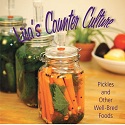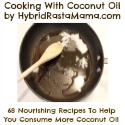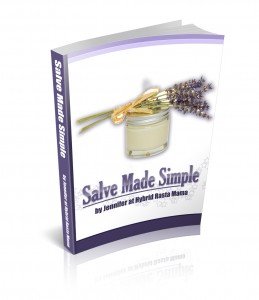Lacto-fermented Bread and Butter Pickles

These are among the favorite ferments of my children and me. These pickles are a mild sweet flavor that is refreshing and easy on the palate for those who are reluctant to eat the more sour or spicy fermented foods. We can’t decide if we like the onions or the cucumbers better. I may just do this ferment this winter just using onions to get the flavor when pickling cukes are no where to be found. I made up my first batch of the summer the other day and my girls kept asking when they would be ready to taste. One thing that I really appreciate about these pickles is that they are done so quickly! No waiting weeks like I have to for dill pickles or months like I do for sauerkraut. You can start eating these within days (but give them at least a week for best flavor).
My recipe is based on this recipe but I changed it for using in an anaerobic jar.
Lacto-fermented Bread and Butter Pickles
- 10.5 cups thinly sliced pickling cucumbers
- 1 large onion thinly sliced
- 1.5 cup fresh lemon juice (about 15 lemons)
- 1 cup honey
- Fine ground natural salt (no additives) I get mine from The Green Polkadot Box
- 2 tablespoons whole celery seeds
- 2 tablespoon mustard seeds
- 2-3 Leaves from grape vine, oak tree, raspberry bush, or even bay leaves or a pinch of tea leaves (the last two may add some flavor that you don’t want but will work in a pinch. They preserve the crispness of the pickles)
- 3 liter fermenting jar
Make sure that they are clean of dirt and sand and slice thinly measuring about 10.5 cups of slices. Combine with the sliced onion and pack into a 3L fermenting jar. Add the mustard and celery seeds to the jar. Press down on the cucumbers so that they are packed firmly in the jar. You want them to be just to the shoulder of the jar so you may need to do some rearranging or add a bit more or take some out to make it fit just right.
In another bowl (I use my 4 cup measuring cup) put the lemon juice, honey and 1.5 cups of water. To that add 33g of your salt. Yes you need to weigh it. Stir till it is dissolved. You can use hot water to make it dissolve easier. I just boil it in my kettle. If that is not enough brine to come up to the shoulder of the jar and submerge the pickles go ahead and make another quart of brine just using water and salt this time. Mix 33g of salt with 1 qt of water. Pour it over the veggies till they are submerged.
Put the airlock in the jar, don’t forget to add water to it and set your pickles to be in a quiet corner wrapped in a towel to protect them from light. Leave them there just 2 days before you move them to the fridge. Thinly sliced pickles don’t need very long to get going.
I like to let them go at least a week in the fridge before we start eating them. This gives the flavors time to really meld and the salt to reduce (fermenting actually consumes salt!)
Be warned that sweet lacto-fermented pickles can’t be kept long term like dills can. The sugar will keep feeding the bacteria and getting eaten up and it will just disappear and your pickles will begin to taste like pickle wine. Also thinly sliced pickles will get mushy and just not hold up long term so enjoy these while they are fresh and don’t make up too many at once. It may be possible to freeze them if you really want some winter sweet pickles but that may make them mushy. I haven’t tried it yet although I did just thaw out some watermelon pickles from last year and they were quite good.

Ingredients
- 10.5 cups thinly sliced pickling cucumbers
- 1 large onion thinly sliced
- 1.5 cup fresh lemon juice (about 15 lemons)
- 1 cup honey
- Fine ground natural salt (no additives) I get mine from The Green Polkadot Box
- 2 tablespoons whole celery seeds
- 2 tablespoon mustard seeds
- 2-3 Leaves from grape vine, oak tree, raspberry bush, or even bay leaves or a pinch of tea leaves (the last two may add some flavor that you don't want but will work in a pinch. They preserve the crispness of the pickles)
- 3 liter fermenting jar
Instructions
- Soak the cucumbers in ice water for at least one hour unless they were freshly picked that day.
- Make sure that they are clean of dirt and sand and slice thinly measuring about 10.5 cups of slices. Combine with the sliced onion and pack into a 3L fermenting jar. Add the mustard and celery seeds to the jar. Press down on the cucumbers so that they are packed firmly in the jar. You want them to be just to the shoulder of the jar so you may need to do some rearranging or add a bit more or take some out to make it fit just right.
- In another bowl (I use my 4 cup measuring cup) put the lemon juice, honey and 1.5 cups of water. To that add 33g of your salt. Yes you need to weigh it. Stir till it is dissolved. You can use hot water to make it dissolve easier. I just boil it in my kettle. If that is not enough brine to come up to the shoulder of the jar and submerge the pickles go ahead and make another quart of brine just using water and salt this time. Mix 33g of salt with 1 qt of water. Pour it over the veggies till they are submerged.
- Put the airlock in the jar, don't forget to add water to it and set your pickles to be in a quiet corner wrapped in a towel to protect them from light. Leave them there just 2 days before you move them to the fridge. Thinly sliced pickles don't need very long to get going.
- I like to let them go at least a week in the fridge before we start eating them. This gives the flavors time to really meld and the salt to reduce (fermenting actually consumes salt!)
- Be warned that sweet lacto-fermented pickles can't be kept long term like dills can. The sugar will keep feeding the bacteria and getting eaten up and it will just disappear and your pickles will begin to taste like pickle wine. Also thinly sliced pickles will get mushy and just not hold up long term so enjoy these while they are fresh and don't make up too many at once. It may be possible to freeze them if you really want some winter sweet pickles but that may make them mushy. I haven't tried it yet although I did just thaw out some watermelon pickles from last year and they were quite good.




10 Comments
Trackbacks/Pingbacks
- Top 10 Signs Your Family is on GAPS | Loving Our Guts - […] Your kids request cups of pickle juice and you think that sounds pretty good and have some […]

















Is it possible to make these in smaller jars - say 1 quart size jars? Also, what would happen if I reduced the amount of honey, say by a third - I know it would be less sweet and so maybe not quite true bread and butter. OR does the fermenting process eat some of the sugar also? (My husband is diabetic)
RoseAnne recently posted…Take Two Pills and Call Me In the Morning
Yes you can make it in smaller jars but do be sure to use an anaerobic jar. I have some sources on my resources page if you don’t have any. I’m not sure what to tell you about the honey. Some of it is consumed in the fermenting process but they still do taste sweet. If they ferment too long they don’t taste very good so I wouldn’t just keep going. What about making a sour pickle? Those don’t have the sugar problem.
Patty - I stumbled upon one of your posts about your daughter and histamine and how anaerobic ferments are helping her. I have a 15 month old who has had a ton of problems with food that I haven’t been able to solve. We are on GAPS - but I haven’t seen any real progress with her yet. The one thing that has helped is digestive enzymes. I haven’t been able to give her much in the way of probiotics b/c she reacts to all the ferments I have tried with her. She sounds similar to your daughter in many ways. I am wondering now if she has a histamine issue. It seems to fit from what I have read so far. My question for you is - what do you know about the histamine content in anaerobic ferments in general? I have read that fermented foods contain high levels of histamine, and I know you said the histamine is reduced in kraut through anaerobic fermentation - is that true of fermented foods generally? Do you know of any resources you can direct me to to learn more on this topic? I am hoping this might be our missing piece :). Thanks!
I will have to look for resources. I have learned it by word of mouth from the inventor of the Pickl-It jar and tried it out and it worked so I was sold.
What I do know is that the histamines go up at first in all ferments but only anaerobic ferments have the right bacteria to break them down and not have them in the final product. I don’t know if they are completely gone or just low enough to not cause issues for my dd who is sensitive to them. (She does react to sauerkraut and pickles that have not gone long enough). I now make my yogurt in an airlock jar as well.
Thanks so much Patty! One more quick question - how long do you ferment the kraut and pickles to get the histamine down? And how long for your yogurt? I’m excited to try this - I really think it might be our answer!
For kraut it needs to go at least 10 weeks. Sometimes longer. I give some to my dd. I have had her face get a rash when I thought that it tasted done. 2 weeks later and she was fine with it.
For pickles, hmmm… they were fine when we tried them after just a few weeks. They were at the half sour stage.
That dd doesn’t like my sweet pickles so I’m not sure about them but pickles are done when the color is uniform. I haven’t noticed her with a rash from those.
I let my yogurt go for 24 hours because we are on GAPS. I don’t know if it has histamine earlier in the process or not.
Is there a suitable sub for the lemon juice? Vinegar or brine or leftover dill pickle juice (bubbies)?
I believe vinegar would be suitable. I think that vinegar is twice as sour as lemon juice so dilute it. Or you could leave it out. It is there for flavor. Don’t use brine from other ferments.
Patty,
Have you tried water kefir? If so, do you know if that can be airlock fermented? Or even if it has the histamine issue? Thanks.
Yes it needs an airlock. I make it all the time and have a recipe on this site.